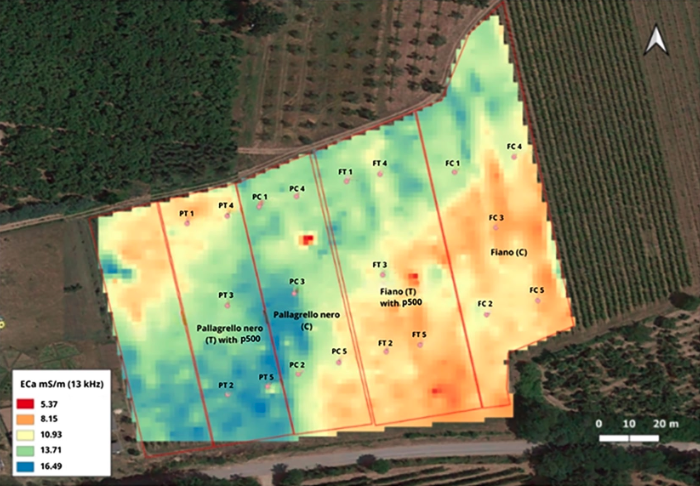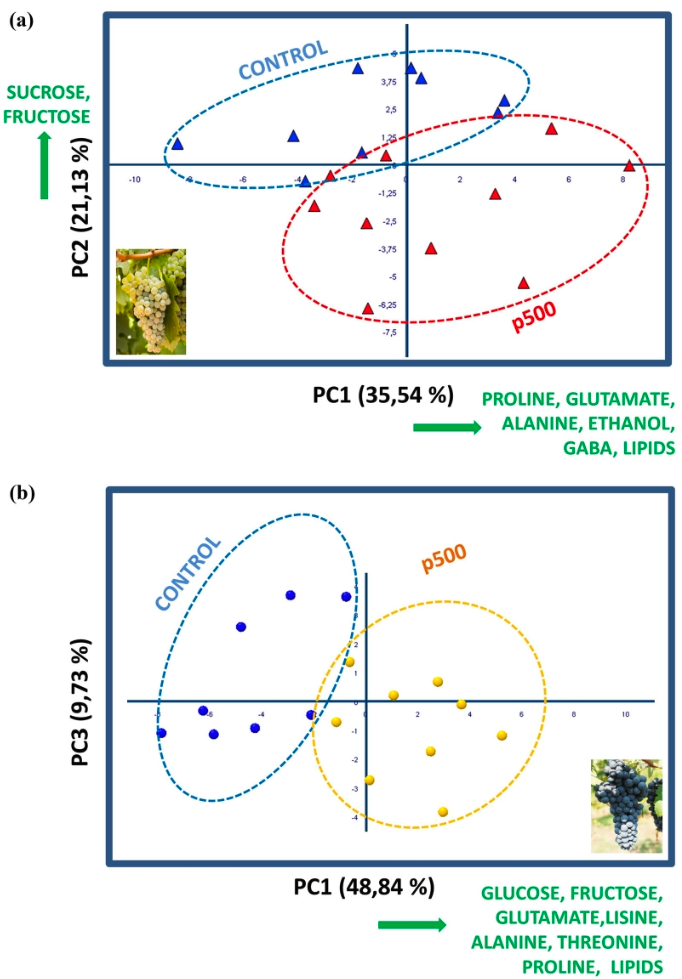Figure 1: Study area in Teano, Italy. The electrical conductivity of the soil is shown in colour. Reddish areas show low conductivity, blue areas show high conductivity. The labelled points mark the sampling locations.
Summary
For this study, Mazzei et al. analysed plots of a vineyard in Teano, Italy, where the two grape varieties Fiano and Pallagrello are grown. Both are among the strategic Italian grape varieties that are of great importance for wine production. In addition to investigating the effect of the field spray 500 on the quality of the grapes, an attempt was also made to determine the optimum soil conditions. The relationship between soil microvariability and grape quality was also investigated.
During the study period, half of the plots were treated twice with the biodynamic preparation 500, while the other half remained untreated. The spatial variability of the soils was measured using electromagnetic induction to map the electrical conductivity. As part of the sample analysis, a spectroscopy method was used to determine amino acids, carbohydrates and organic acids. Magnetic resonance imaging was used to analyse the internal structure and water distribution within the grapes. The levels of phenols and antioxidant activity were determined using chemical analyses.
The results show that grapes treated with preparation 500 had higher levels of phenols and antioxidants, as well as a higher concentration of amino acids and a lower sugar content. Magnetic resonance imaging revealed differences in the distribution of water and the structure of the vascular bundles in the grapes. Depending on the electrical conductivity in the soil, which reflects variations in the contents of water, clay and organic substances in the soil, sugar and amino acid contents vary in both grape varieties. Overall, grape quality was significantly influenced by both soil microvariability and the biodynamic spray preparation.
Figure 2: Results of the spectral analysis of the grape varieties Fiano (a) and Pallagrello (b), separated according to control trial and treatment with preparation BD500. The most significant trends are shown in green. Reading example: The use of preparation BD500 led to an increase in the content of glucose, glutamate and lipids in the Pallagrello grape variety.
In-depth
The samples were analysed with HRMAS-NMR and MRI. What does that mean?
- HRMAS-NMR stands for High-Resolution Magic Angle Spinning Nuclear Magnetic Resonance. It is a specialised form of nuclear magnetic resonance spectroscopy that is suitable for analysing soft samples (in this case grape tissue). With this method, individual molecules such as sugar, amino acids or organic acids can be analysed directly in intact tissue and without complex preparations.
- MRI stands for Magnetic Resonance Imaging and makes it possible to generate images of the interior of water-containing structures using the interaction of hydrogen nuclei with a strong magnetic field. When analysing grapes, for example, MRI images show the distribution of water within the grape, as well as seeds and cell structures. Water movements can also be visualised.
Figure 3: MRI image of Fiano grapes (a, b) and Pallagrello grapes (c, d).
What aspects of this study are particularly interesting from a biodynamic perspective?
From the point of view of biodynamics, it is particularly interesting that the study provides scientific proof of the effectiveness of the biodynamic preparation 500. The preparation has been shown to influence the metabolic, structural and nutritional properties of the grapes studied. This supports the idea that biodynamic methods are not only ecologically sustainable, but also qualitatively beneficial for wine production. In addition, the study clearly shows that even small differences in soil properties have a significant impact on the composition of the grapes. Sustainable, ecological soil management, as taught by biodynamics, promotes grape quality.
What are the limitations of this study?
A number of points should be taken into consideration when interpreting the results of the study:
- The study only covers one growing season on a single biodynamic farm. Long-term effects and seasonal fluctuations are not taken into account, and the results are not easily transferable to other regions, soils or grape varieties.
- The study shows a correlation between the biodynamic preparation BD500 and soil microvariability, but cannot establish causality, for example due to insufficient investigation of soil microbial activity.
- Although the use of HRMAS-NMR and MRI is innovative, its application is still limited, as is the robustness of the conclusions drawn from it.
- The study examines the use of the preparation, but no comparison is made with other biostimulants. A relative comparison of the preparation's effectiveness is therefore not possible.
To summarise, the study by Mazzei et al. offers stimulating results and innovative analysis methods for the investigation of biodynamically treated grapes. Due to the risk of accumulation of harmful substances in the soil of long-term agricultural areas such as vineyards, the use of ecologically sustainable products is essential. Compared to the control trial, the biodynamic spray preparation BD500 increases the quality of the grapes.
Sources and further links to this article
- Original study:
Mazzei, P., Sica, A., Migliaro, C., Altieri, G., Funicello, N., De Pasquale, S., Piccolo, A., Celano, G. MRI and HR-MAS NMR spectroscopy to correlate structural characteristics and the metabolome of Fiano and Pallagrello grapes with the action of field spray preparation 500 and the soil spatial microvariability. Chem. Biol. Technol. Agric. 11, 131 (2024). https://doi.org/10.1186/s40538-024-00620-x - The study is covered by Creative Commons (link to licence) and has been summarised for this study report.
- Study report ‘Copper in viticulture - effective fungicide or problematic pollutant?’
- Study report ‘DOK study compares the soil quality of different cultivation systems after 42 years of agricultural use’
- Demeter International's overview page on biodynamic preparations, including the field spray preparation 500


